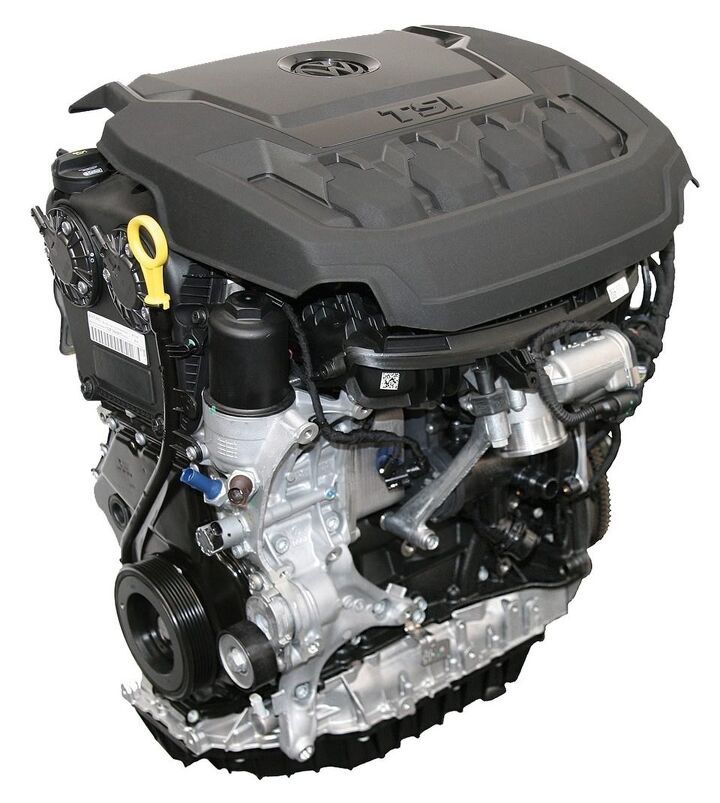Another New Volkswagen 2.0T Debuts in 2018 Tiguan, Prepares to Replace 1.8T in Passat and Beetle
Complete with an alternate Miller Cycle that Volkswagen is calling the “Budack Cycle,” the German automaker has evolved its ubiquitous EA888 2.0-liter turbocharged four-cylinder engine for installation in the second-generation 2018 Volkswagen Tiguan.
Horsepower? For a 2.0T, it’s rather unimpressive at only 184 ponies. But Volkswagen isn’t caught up in horsepower per liter figures. Instead, Volkswagen’s own introduction of this “Budack Cycle” 2.0T makes the company’s existing 1.8T — currently on duty in four product lines — sound downright ineffective.
Naturally then, Volkswagen won’t reserve the Budack Cycle EA888 2.0T solely for the 2018 Tiguan. According to Volkswagen of America communications manager Mark Gillies, “It will eventually supersede the 1.8T in the Passat and Beetle.”
From this we learn two things.
First, the EA888 Gen3B 184-horsepower 2.0T isn’t bound for the Golf and Jetta, the latter of which is due for replacement next year. Second, the existing Beetle that is oft rumored to be dead will clearly live — at least long enough — to see the installation of a new engine.
As for the EA888 Gen3B powerplant that will first appear in the Tiguan, it’s no powerhouse compared to the 2.0T in, say, the Volkswagen Golf R. There, Volkswagen’s 2.0T produces 292 horsepower.
But again, it’s not the displacement that matters as much to Volkswagen as the comparison with the 1.8T and the old Tiguan’s premium fuel-swilling 2.0T. Prior to official numbers being made available by the EPA, Volkswagen says the new 2.0T will consume less fuel than the 1.8T while producing 21 percent more torque: 221 lb-ft, 14 more than the old Tiguan’s old 2.0T.
Volkswagen says the additional torque is produced because this new 2.0T “closes the intake valves much earlier.” Along with prolonging combustion, this means “faster air flow for the incoming gases, which improves the mixing of the fuel and air.”
While the 2.0T produces only 14 more horsepower than the existing 1.8T, the peak pony output arrives at 4,400 rpm rather than 4,800. All 221 lb-ft of torque are accessible at a low 1,600 rpm.
At least for 2018, the new Tiguan’s powerplant offerings will be limited to the 184-horsepower 2.0T. Keep in mind, the two best-selling utility vehicles in its segment — Rogue and CR-V — don’t offer hi-po engine upgrades, either.
Timothy Cain is the founder of GoodCarBadCar.net and a contributing analyst at The Truth About Cars and Autofocus.ca. Follow on Twitter @timcaincars.
More by Timothy Cain
Latest Car Reviews
Read moreLatest Product Reviews
Read moreRecent Comments
- Proud2BUnion I typically recommend that no matter what make or model you purchase used, just assure that is HAS a prior salvage/rebuilt title. Best "Bang for your buck"!
- Redapple2 jeffbut they dont want to ... their pick up is 4th behind ford/ram, Toyota. GM has the Best engineers in the world. More truck profit than the other 3. Silverado + Sierra+ Tahoe + Yukon sales = 2x ford total @ $15,000 profit per. Tons o $ to invest in the BEST truck. No. They make crap. Garbage. Evil gm Vampire
- Rishabh Ive actually seen the one unit you mentioned, driving around in gurugram once. And thats why i got curious to know more about how many they sold. Seems like i saw the only one!
- Amy I owned this exact car from 16 until 19 (1990 to 1993) I miss this car immensely and am on the search to own it again, although it looks like my search may be in vane. It was affectionatly dubbed, " The Dragon Wagon," and hauled many a teenager around the city of Charlotte, NC. For me, it was dependable and trustworthy. I was able to do much of the maintenance myself until I was struck by lightning and a month later the battery exploded. My parents did have the entire electrical system redone and he was back to new. I hope to find one in the near future and make it my every day driver. I'm a dreamer.
- Jeff Overall I prefer the 59 GM cars to the 58s because of less chrome but I have a new appreciation of the 58 Cadillac Eldorados after reading this series. I use to not like the 58 Eldorados but I now don't mind them. Overall I prefer the 55-57s GMs over most of the 58-60s GMs. For the most part I like the 61 GMs. Chryslers I like the 57 and 58s. Fords I liked the 55 thru 57s but the 58s and 59s not as much with the exception of Mercury which I for the most part like all those. As the 60s progressed the tail fins started to go away and the amount of chrome was reduced. More understated.



































Comments
Join the conversation
So, all you need to do to wake this engine up is a cam with more intake duration and a tune?
Seems like this engine would pretty much moot the point of the TDIs even if they weren't gone for other reasons. 221 lb-ft from 1600 RPM, great efficiency, etc.